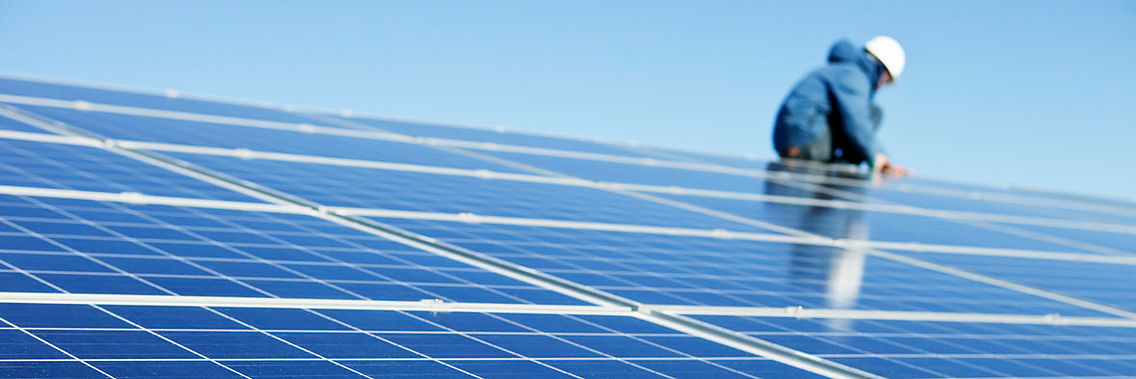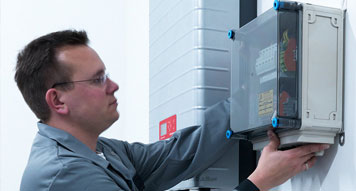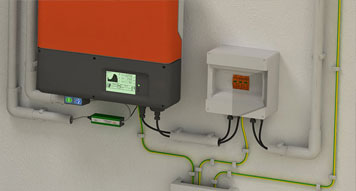The procurement of a photovoltaic system (PV system) is always connected with high levels of investment, which should prove its worth as quickly as possible. This makes their continuous availability that much more important.
What must you take into account regarding the subject of photovoltaics? As PV systems are installed on a roof or in an open location, they are particularly susceptible to lightning strikes and surge voltages. If the PV system is damaged, then the yield is lost for the duration of the repair work. In addition, extra costs are incurred, for example through the exchange of the inverter. With OBO, you are always on the safe side: We can offer comprehensive system solutions to protect your PV system against lightning strikes and surge damage.
Your advantages at a glance:
- Complete system for almost any electrical requirements of a PV system
- System solutions for rapid and continuously safe installations
- Tailor-made support for the erection and operation of PV system solutions
- Long-term experience and competence connected with the protection and supply of PV systems
- Practical, comprehensive PV training courses
- Knowledgeable installation and planning aids
- Investment and legal security
Quickstart
System solutions
No matter which PV system type you wish to implement: With OBO, you can find the matching system solutions for the following areas of competence:
Downloads
FAQ
- Which measures must I take to protect PV systems?
DIN VDE 0100-712 requires that, at the transition point of the electrical system (house connection box or main distribution), a standardised information sign must be attached. The information sign is also known as a fire brigade sign and helps fire brigades to recognise the PV system. Accordingly, the extinguishing measures are then carried out whilst maintaining the safety spacings according to DIN VDE 0312. In addition, safe routing of the DC cables must be ensured. They must be safely routed to avoid damage to the insulation, in order to guarantee the safe rescue of people in the event of fire. According to VDE-AR-2100-712, protection is possible using suitable separation or a fire protection duct, such as the PYROLINE® Sun PV.
- What do I need for the external lightning protection of photovoltaic roof systems?
Primarily: Good planning. In addition, the following are required for the reliable external lightning protection of PV systems: Round wire/flat conductor, routing blocks, air-termination rods, connectors, holders, expansion pieces and other system-relevant components. You can find additional information on the external lightning protection of PV systems here.
- How do I install external lightning protection in combination with a photovoltaic system?
Always include the PV system in the planning of the lightning protection system, meaning that you can ensure that the lightning protection system does not cast a shadow on the PV system as the yield could otherwise be reduced. The installation itself is then the same as for any other lightning protection system.
- How do I maintain separation distances to the lightning protection system in a photovoltaic system?
The separation spacings for the lightning protection system are determined according to VDE 0185-305-3. If these spacings cannot be maintained with a conventional lightning protection system, then the separation spacing can be reduced by up to 90 cm through the use of the different OBO isCon conductors. You can find additional information on our isCon system here.
- What options do I have for strain relief of vertical cable routing in a photovoltaic system?
There are various options for creating a safe vertical supply. However, it is essential that cables are fastened with suitable measures at specific distances, if it is clear that their routing type is not continually supported.
Vertical ladder systems are the optimum solution for vertical routing. A further option is routing directly on the wall. Profile rails with appropriate clamp clips or individual clips are fastened directly on the wall or on a steel structure.
- How do I best protect the inverter in a photovoltaic system?
To offer optimum protection to the inverter of the PV system, a surge protective device should always be used on the DC side. On the AC side, at least one surge protective device must be used at the supply point of the electrical system. If the inverter is more than a 10 m cable length away from the supply point, then the surge protection should be repeated on the AC side, directly before the inverter.
In the case of an electrical system and an external lightning protection system, an arrester, type 1(+2), should always be used on the AC side. A type 1(+2) arrester is required on the DC side if the PV system is electrically integrated into the external lightning protection system. In all other cases, SPDs of type 2 are sufficient.
- How do I route cables in the area of emergency and escape routes with a photovoltaic system?
If the installations are in escape and rescue routes, then the PV DC cables must be routed in encapsulated form. The construction requirements can be found in the state construction regulations.
The PYROLINE® Sun PV fire protection duct is the ideal solution for fireproof routing of photovoltaic DC cables. This duct fulfils the requirements as an I duct according to DIN 4102 Part 11 for cable installations in emergency and escape routes. In addition, it meets the requirements of the VDE application rule AR 2100-712. The duct is made of water- and frost-resistant glass fibre lightweight concrete fire protection plates (non-combustible, material class A1), meaning that it can also be routed in external areas.
Support
Requirements

Taking responsibility, securing the system.
A wide range of standards and regulations must be complied with for the erection of a lightning protection system for a PV system. The erection engineer of the PV system is liable for correct fulfillment for 30 years. The requirements of the insurance company come on top of that.
The specialist company installing an electrical system is required by law to hand it over in perfect condition.
Responsibility of the operator
Through the feed-in of the gained energy, almost every PV system is subject to the requirements for commercial use. For the system operator, this creates the obligation, according to the accident prevention requirement BGV A3, to give the system the proper maintenance, checking and repairs.
These regular recurring checks of the electrical system components must be carried out by an electrical technician.
Relevant standards
Low-voltage electrical installations
> DIN VDE 0100-100 (IEC 60364-1)
> DIN VDE 0100-534 (IEC 60364-5-53)
> DIN VDE 0100-410 (IEC 60364-4-41)
> DIN VDE 0100-443 (IEC 60364-4-44)
> DIN EN 60664-1 (IEC 60664-1)
Commissioning test and documentation
> VDE 0100-600 (IEC 60364-6)
> VDE 0105-100 (EN 50110-1)
Requirements for PV power supply systems
> DIN VDE 0100-712 (IEC 60364-7-712)
> DIN EN 62446 (IEC 62446)
> DIN CLC/TS 61643-12 (IEC 61643-12)
> DIN CLC/TS 50539-12 (CLC/TS 51643-32, IEC 61643-32)
> VDE 0185-305-3 Supplement 5
Lightning protection systems and earthing systems
> DIN EN 62305-1 to -4 (IEC 62305-1 to -4)
> Local additional requirements (e.g. state building regulations in Germany)
> DIN 18014
> DIN VDE 0100-540 (IEC 60364-5-54)
Fire protection in the PV area
> VDE-AR-E 2100-712
Construction regulations
> EN 13501-1/-2, DIN 4102-1/-2 Fire classification of construction products and building elements
> The national and regional construction regulations must be observed with regard to the use of construction products. These include, for example, the state construction regulations in Germany, VKF regulations in Switzerland and OIB directives in Austria
This list makes no claim to completeness! Please observe the appropriate local and statutory requirements.
Are you uncertain as to which measures you need to take to protect your PV system? If so, our graphic will help you,and will guide you, step by step, to the right protection measures.







